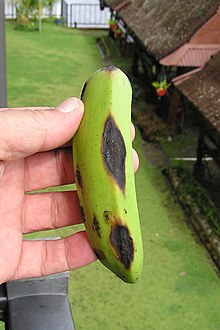
Black sigatoka is a leaf-spot disease of banana plants caused by the ascomycete fungus Mycosphaerella fijiensis (Morelet), also known as black leaf streak. It was discovered in 1963 and named for its similarities with yellow Sigatoka, which is caused by Mycosphaerella musicola (Mulder), which was itself named after the Sigatoka Valley in Fiji. In the same valley an outbreak of this disease reached epidemic proportions from 1912 to 1923.
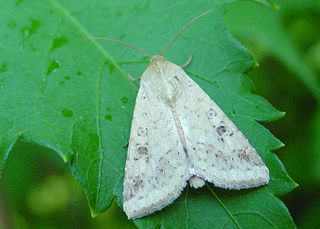
Helicoverpa armigera is a species of Lepidoptera in the family Noctuidae. It is known as the cotton bollworm, corn earworm, Old World (African) bollworm, or scarce bordered straw. The larvae feed on a wide range of plants, including many important cultivated crops. It is a major pest in cotton and one of the most polyphagous and cosmopolitan pest species. It should not be confused with the similarly named larva of the related species Helicoverpa zea.

Cochliobolus miyabeanus is a fungus that causes brown spot disease in rice.
Glomerella graminicola is an economically important crop parasite affecting both wheat and maize where it causes the plant disease Anthracnose Leaf Blight.
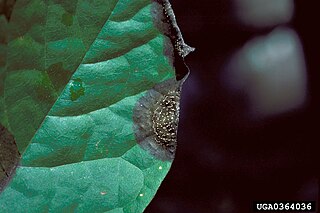
Colletotrichum acutatum is a plant pathogen and endophyte. It is the organism that causes the most destructive fungal disease, anthracnose, of lupin species worldwide. It also causes the disease postbloom fruit drop on many varieties of citrus, especially Valencia and navel oranges in Florida.
Colletotrichum trifolii is a fungal plant pathogen of alfalfa, causing the disease alfafa anthracnose. It is a biotroph, obtaining nutrients from the living plant cells before forming asexual spores. This fungus has two known races Bain and Essary.
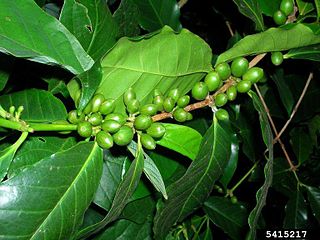
Colletotrichum kahawae is a fungal plant pathogen that causes coffee berry disease (CBD) on Coffea arabica crops. The pathogen is an ascomycete that reproduces asexually. The asexual spores (conidia) are stored within acervuli. This disease is considered to be one of the major factors hampering C.arabica production in the African continent, which represents the current geographic range of the fungus. Coffee berry disease causes dark necrosis in spots and causes the green berries of the coffee to drop prematurely. High humidity, relatively warm temperatures, and high altitude are ideal for disease formation. Given the severity of the disease and the lack of effective control measures, there is great concern that the fungus may spread to other coffee producing continents, such as South America, which could have catastrophic consequences.
Mycosphaerella henningsii is a fungal plant pathogen that causes Brown leaf spot (BLS) in cassava).Part
Septoria cucurbitacearum is a fungal plant pathogen infecting cucurbits. Symptoms of Septoria leaf spot are similar on all the cucurbits infected.
Elsinoë mangiferae, common name "mango scab", is also known Denticularia mangiferae or Sphaceloma mangiferae (anamorph). It is an ascomycete plant pathogen native to tropical regions and specific for survival on only one host, the mango. Originally described in 1943 from Florida and Cuba specimens, this pathogen has since spread worldwide and is becoming a pathogen of great concern for the mango industries in Australia and India. The species was first described formally in 1946.

Colletotrichum coccodes is a plant pathogen, which causes anthracnose on tomato and black dot disease of potato. Fungi survive on crop debris and disease emergence is favored by warm temperatures and wet weather.

Colletotrichum orbiculare is a plant pathogen of melons and cucumber. It causes the disease anthracnose that can effect curcubits causing lesions on various parts of the plant. It can effect cucumbers, melon, squash, watermelon and pumpkin, especially when the weather is rainy, humid and warm. It can be transmitted by seed as well as soil and survive between crops. It is also spread by feeding cucumber beetles, splashing water, tools and workers. Efforts to control the fungus include the practice of rotating cucurbits out for a 2-year period, planting cultivars with resistance, burning infected crops and careful control of weeds. Chemical control measures are also available.
Colletotrichum truncatum is a fungal species and plant pathogen on soybeans.

Glomerella cingulata is a fungal plant pathogen, being the name of the sexual stage (teleomorph) while the more commonly referred to asexual stage (anamorph) is called Colletotrichum gloeosporioides. For most of this article the pathogen will be referred to as C. gloeosporioides. This pathogen is a significant problem worldwide, causing anthracnose and fruit rotting diseases on hundreds of economically important hosts.

Colletotrichum sublineola is a plant pathogen that causes anthracnose in wild rice and sorghum
Colletotrichum fragariae is a fungal plant pathogen infecting strawberries. It is not a well known fungus, and there are many similar fungi that are related to it. It is part of the Colletotrichum genus. It is a pathogen that occurs in strawberries. It leads to the disease known as anthracnose. This is typically at the crown of the strawberry, which is why it is often called crown rot. It is also known as the Anthracnose Crown rot. The fungus also infects leaves and is known as leaf spot, which is common among all Colletotrichum. This is not as common in the fragariae, as it is more common in the crown. This fungus is also better at infecting younger strawberries/seedlings. The most common way to control this disease is fungicides that are harmful to the environment. There have been studies done to see if the fungus infects other hosts but other than some weeds, it is very specific to Strawberries.
Colletotrichum cereale is a plant disease (fungus) that has been found to cause crown rot anthracnose of turf grass most commonly occurring on golf courses. Anthracnose can occur as both a foliar blight and basal rot. This disease attacks the crowns of plants, which is different than other anthracnose diseases. Anthracnose of turfgrass can be a foliar disease or in this case a basal rot of the lower portion of the plant. It attacks different species of turfgrass throughout the world most commonly annual bluegrass and creeping bentgrass.
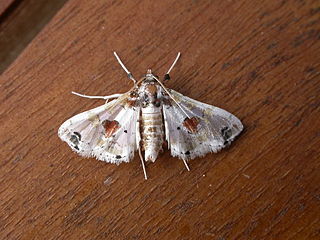
Leucinodes orbonalis, the eggplant fruit and shoot borer or brinjal fruit and shoot borer, is a moth species in the genus Leucinodes described by Achille Guenée in 1854. Its native distribution is in the tropical and subtropical parts of Australia and Asia, where it is recorded from Pakistan, Nepal, India, including the Andaman Islands, Sri Lanka, Bangladesh, Myanmar, Laos, Cambodia, Vietnam, Thailand, China, Taiwan, Japan, Malaysia, Singapore, Brunei, the Philippines, and Indonesia (Java). It has also been intercepted from fruit imports in the U.S.A., the Netherlands, Denmark and Great Britain, where it was also reported from the wild. A taxonomic revision of the Leucinodes species of Sub-Saharan Africa concluded that L. orbonalis is currently not present in Africa, and that previous records of this species were misidentifications of previously undescribed species.

Busseola fusca is a species of moth that is also known as the maize stalk borer. It is known from Ethiopia.

Banana Xanthomonas Wilt (BXW), or banana bacterial wilt (BBW) or enset wilt is a bacterial disease caused by Xanthomonas campestris pv. musacearum. After being originally identified on a close relative of banana, Ensete ventricosum, in Ethiopia in the 1960s, BXW emanated in Uganda in 2001 affecting all types of banana cultivars. Since then BXW has been diagnosed in Central and East Africa including banana growing regions of: Rwanda, Democratic Republic of the Congo, Tanzania, Kenya, Burundi, and Uganda.
